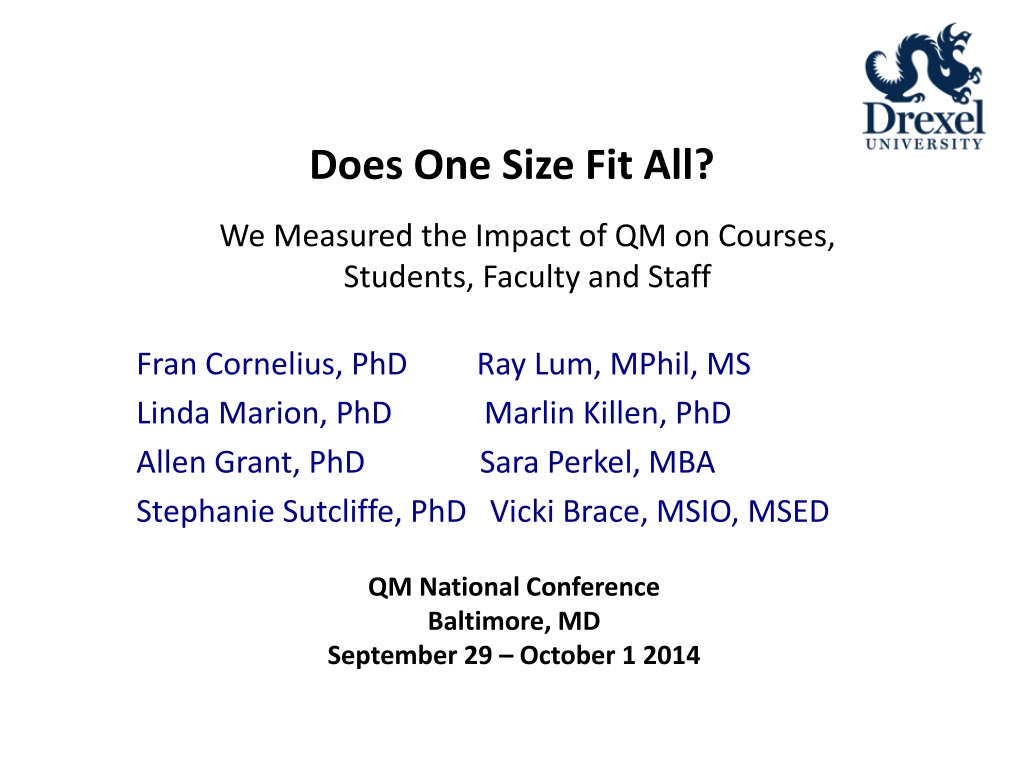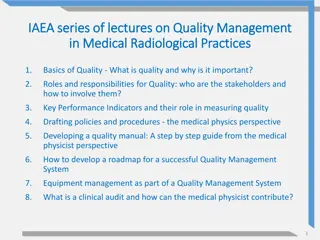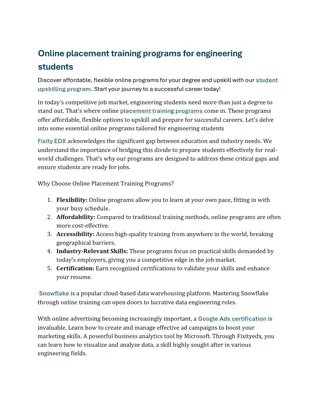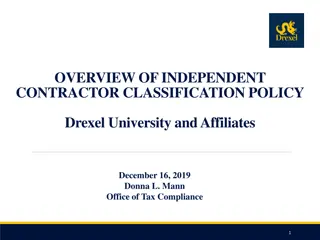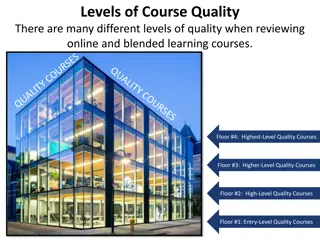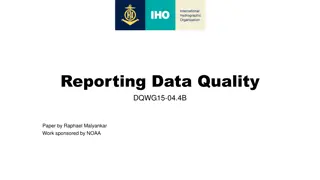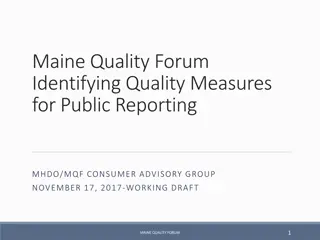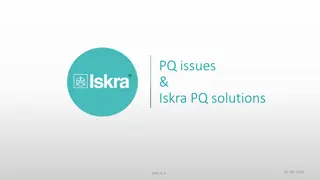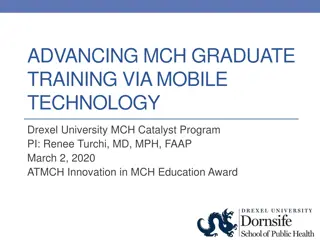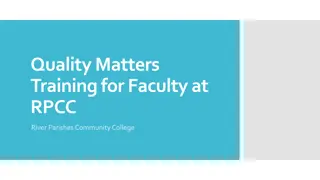Measuring the Impact of Quality Matters on Online Programs at Drexel University
Explore the impact of Quality Matters (QM) on courses, students, faculty, and staff at Drexel University through the presentation discussing alternative pathways for achieving quality in online programs. Learn about leveraging internal QM reviews to improve institutional culture and quality, with a focus on the Drexel University Core Design Element Checklist and outcomes from course reviews. Discover strategies for engaging academic stakeholders and fostering cultural change for quality improvement initiatives.
Download Presentation

Please find below an Image/Link to download the presentation.
The content on the website is provided AS IS for your information and personal use only. It may not be sold, licensed, or shared on other websites without obtaining consent from the author. Download presentation by click this link. If you encounter any issues during the download, it is possible that the publisher has removed the file from their server.
E N D
Presentation Transcript
Does One Size Fit All? We Measured the Impact of QM on Courses, Students, Faculty and Staff Fran Cornelius, PhD Ray Lum, MPhil, MS Linda Marion, PhD Marlin Killen, PhD Allen Grant, PhD Stephanie Sutcliffe, PhD Vicki Brace, MSIO, MSED Sara Perkel, MBA QM National Conference Baltimore, MD September 29 October 1 2014
Description This presentation will engage program attendees in a discussion of the value of alternative pathways to achieve quality in online programs, transform organizational culture and to demonstrate the impact of internal QM reviews on institutional culture and quality improvement on programs and courses. The process of leveraging the internal capacity of 75 QM trained reviewers, identifying measurable outcomes and developing alternative pathways that 'fit' will be presented. Such an alternative pathway is the Drexel University Core Design Element Checklist.
Learning Outcomes 1. 2. 3. Identify Quantitative Outcome Measures Identify Themes in Feedback about the QM Process Identify Academic Organization to Gain QM Acceptance and Participation
Presentation Outline 1. Background 1. Drexel University 2. Online Learning Council 3. Online Learning Council Fellows 2. Comparison of Drexel Core Design Element Checklist to QM Standards 3. Reaching out to Critical Academic Stakeholders to Achieve Scalability and Sustainability 4. Qualitative and Quantitative Outcomes from Course QM and DUCDEC reviews 5. Observed Themes from Faculty Participation 6. Scenarios for Institutional Culture Change and Quality Improvement Initiatives Is this a model that you can use? 7. Conclusion
Drexel University Background and Context Online Learning Successes 2010 Sloan-C Award for Excellence in Institutional-Wide Online Education Moduleed States Distance Learning Association s USDLA 21st Century Distance Learning Award 2012 Drexel University ranked second in the Moduleed States in its online graduate nursing program according to U.S. News and Word Report Ranking Drexel received special acclaim for Student Services and Technology and Student Engagement and Accreditation Ref: Professional Development for Online Faculty (2013) : Presented by Drexel University Online Council Fellows 5
Drexel University Background and Context Tremendous Growth 6
Drexel University Background and Context Online Scalability Challenges 115 online programs 15 undergraduate, 44 graduate, 56 certificate 7358 fully online including 2459 undergraduate, 4147 graduate and 752 certificate program students In addition, 17,601 undergraduate and graduate students Approximately, 650 faculty members teach online including 336 graduate and 318 undergraduate level. Ref: Professional Development for Online Faculty (2013) : Presented by Drexel University Online Council Fellows 7
Drexel University Background and Context A Move Towards Measuring Method of Delivery The Instruction Method field will be used to identify the method of delivery for a section. The codes will be: o FTF - Face to Face o HYB - Hybrid o ONL - Online Online (ON) and Hybrid (LH, BH, RH) schedule types will no longer be used. Example: For a course with allowable schedule types of Lecture (L) & Online (ON): Schedule Type: L Instructional Method: ONL For a course with allowable schedule types of Recitation (R) & Recitation/Online Hybrid (RH): Schedule Type: R Instructional Method: HYB OUR (Office of the University Registrar) will monitor and audit contact hours for hybrid courses to ensure the correct amount of in-class meeting hours are offered. Effective AY 14-15 8
ONLINE LEARNING COUNCIL Overview The Online Learning Council (OLC) was envisioned in 2009 by our Provost, Mark Greenberg, others in Provost's Office, and Drexel academic leadership. Leveraging over four years of experience, collaboration, and engagement, the current OLC membership has grown to involve nearly 100 faculty, TAs, and professional staff from across the university. The Council's Purpose is to inform and enhance the academic experience Drexel faculty and students enjoy, particularly with respect to the ways in which the infusion of technology and advanced pedagogies can support that achievement. The outcomes could be enhanced teaching practice through an engaging and dynamic learning experience for students in face-to-face, hybrid, or online courses.
ONLINE LEARNING COUNCIL Vision The Vision for the Online Learning Council is that an inclusive array of dedicated academic and administrative representatives from across the Drexel University community comes together on a regular basis to focus on enhancing the academic experience of its faculty and students in various ways. The OLC will develop, demonstrate, and share strategies that will have positive and lasting impact on the design, delivery, and outcomes of Drexel s online, hybrid, and enhanced face-to-face courses.
ONLINE LEARNING COUNCIL Mission The Mission of the Online Learning Council will enable the OLC Vision to become a reality through the work of its Committees focused on (but not limited to) course quality, student services, student retention, scalability, and accessibility through communication, discovery, training, information sharing, support, partnerships, and cross-discipline engagement.
ONLINE LEARNING COUNCIL OLC Committee The Purpose of each OLC Committee will enable the OLC Mission to become a reality through Committee members discovering, vetting, sharing, supporting, and showcasing (disseminating) ways in which Drexel educators and administrators can most effectively enhance the Drexel student experience in their respective areas. ACCESSIBILITY COMMUNICATIONS QUALITY RETENTION SCALABILITY STUDENT SERVICES & ENGAGEMENT
ONLINE LEARNING COUNCIL OLC Fellows The primary charge of the OLC Fellows is to disseminate and proliferate the work of the Council to the Drexel wide community and serve as catalysts for quality and innovation in education. The OLC Fellows provide a wide variety of support services including faculty mentorship, course design consultation and course design reviews. The Course Design Review Program is intended to provide instructors with constructive, collegial, and confidential feedback on the design of their online or hybrid course. Instructors will have three options for course design reviews: Self-Review (using Core Design Elements Checklist, a self-paced Course in Blackboard Learn) Drexel University Core Design Elements Checklist review (conducted by one Fellow) Quality Matters Rubric review (conducted by a team of three Fellows) The Fellows are Quality Matters certified Master Reviewers and can help faculty consider approaches for aligning University, program and course learning outcomes and advancing course quality, student engagement, and assessment strategies.
Drexel University Core Design Element Checklist 1. A course description is provided. a. This may include a statement that introduces the student to the purpose of the course and its components. b. In the case of a hybrid course, there is a statement that clarifies the relationship between the face-to-face and online components. c. The number of credit hours earned for successful completion is clearly posted. 8. Due dates and deadlines are provided. a. A disclaimer that dates are subject to change should be included. 9. A code of conduct and information about academic integrity are provided. a. Links to university policies should be provided. b. Netiquette standards should be provided as needed. 2. The grading policy is clearly stated. a. Specific/descriptive criteria are provided for the evaluation of student work and participation. b. Instructions for completion and submission are provided. c. Grading scales and weights are provided. 10. Links, email addresses, and/or phone numbers to technical support are provided. 11. Content is sequenced and structured in a manner that enables learners to achieve the stated goals. a. The course content is divided into learning Modules that are labeled and presented in a logical manner. 3. Course learning objectives describe outcomes that are measurable. 4. Assessment and evaluation are aligned with course learning objectives. a. Assessment and evaluation tools are appropriate for measuring the stated learning outcomes. b. Assessment and evaluation goals are clearly communicated. 12. The course is easy to navigate. a. The components and structure of the course are clear and understandable. b. Instructions about how to get started and where to find various course components is provided. 5. Information about student feedback is provided. 13. Broken or outdated links are corrected or removed. a. Required online resources are accessible. 6. Instructor contact and availability information is provided. 14. Links to academic resources are provided. a. Links to Drexel Express, library, tutoring centers, counseling services, Provost Office, DragonCard Office, and bookstore are provided. 7. A list of textbooks, supplies, and other instructional materials needed for the course is provided. 15. The university statement regarding ADA compliance is provided. a. Information about how to request special Services is provided. 14
Drexel University Core Design Element Checklist versus Quality Matters DUCDEC QM QM 1.2 (3) Learners are introduced to the purpose and structure of the course. QM 3.2 (3) The course grading policy is stated clearly. QM 2.2 (3) The module/unit learning objectives or competencies describe outcomes that are measurable and consistent with the course-level objectives or competencies. 1. A course description is provided 2. The grading policy is clearly stated. 3. Course learning objectives describe outcomes that are measurable.
Drexel University Core Design Element Checklist versus Quality Matters DUCDEC QM QM 3.1 (3) The assessments measure the stated learning objectives or competencies. QM 5.3 (3) The instructor s plan for classroom response time and feedback on assignments is clearly stated. 4. Assessment and evaluation are aligned with course learning objectives. 5. Information about student feedback is provided.
Drexel University Core Design Element Checklist versus Quality Matters DUCDEC QM QM 1.1 (3) Instructions make clear how to get started and where to find various course components. QM 4.3 (2) All instructional materials used in the course are appropriately cited. 6. Instructor contact and availability information is provided. 7. A list of textbooks, supplies, and other instructional materials needed for the course is provided.
Drexel University Core Design Element Checklist versus Quality Matters DUCDEC 8. Due dates and deadlines are provided. 9. A code of conduct and information about academic integrity are provided. QM N/A QM 1.4 (2) Course and/or institutional policies with which the learner is expected to comply are clearly stated, or a link to current policies is provided. QM 7.1 (3) The course instructions articulate or link to a clear description of the technical support offered and how to obtain it. 10. Links, email addresses, and/or phone numbers to technical support are provided.
Drexel University Core Design Element Checklist versus Quality Matters DUCDEC 11. Content is sequenced and structured in a manner that enables learners to achieve the stated goals. QM QM 4.2 (3) Both the purpose of instructional materials and how the materials are to be used for learning activities are clearly explained. QM 8.1 (3) Course navigation facilitates ease of use. N/A 12. The course is easy to navigate. 13. Broken or outdated links are corrected or removed.
Drexel University Core Design Element Checklist versus Quality Matters DUCDEC QM QM 7.3 (2) Course instructions articulate or link to an explanation of how the institution s academic support services and resources can help learners succeed in the course and how learners can obtain them. QM 8.2 (3) Information is provided about the accessibility of all technologies required in the course. 14. Links to academic resources are provided. 14. The university statement regarding ADA compliance is provided.
Drexel University Core Design Element Checklist versus Quality Matters DUCDEC 1 Reviewer 15 Core Elements (Overlaps with 10 QM Required Standards) Less time/resources for review Good for Beginners Inspirational Achievement Scalability and Sustainability QM 3 Reviewers 21 Required Standards and Score of 84 More time/resources for review Good for Experience Aspirational Achievement Scalability and Sustainability
Academic Stakeholders that Gained Acceptance of QM Standards to Achieve Scalability and Sustainability Senior University Admin Support Provost Drexel Online Online Learning Team President (Part of Strategic Initiative) College Support Faculty Support Faculty Senate Educational Coordinating Committees Faculty Driven Instructional Designer Support Centralized vs. Decentralized Model
OLC Fellows Summary of Outcomes Qualitative Awareness Interest Engagement Dissemination Quantitative 29 Consultation 28 DUCDEC reviews 5 internal QM reviews
OLC Fellows Qualitative Outcomes Awareness New Online Faculty Training New online faculty in any Drexel college may take this course. Content Areas: Online vs. Face-to-Face Teaching Strategies for Teaching Online Personal Development Plan Resources for New Online Instructors Delivery Options: Online self-paced Virtual, synchronous Face-to-face Professional Development New Online Faculty Training Course The ABC's of QM: getting ready for a course design review Evidence Based Learning- Creating a Culture of Assessment Raising the Bar Workshop Series Educational TechFest If you Build It, Will They Come? Drexel Assessment Conference
OLC Fellows Qualitative Outcomes Interest Consultation and Mentorship Meet with individual faculty on request to discuss design issues Can be a single meeting or ongoing relationship Can be in conjunction with a review or independent Seeing more interest in teaching mentorship as well Course Review Program Self-review Peer-review DUCDEC Internal Quality Matters Review This process is: Voluntary Confidential Collegial Focused on design, not instruction
OLC Fellows Qualitative Outcomes Engagement Request for Course Design Review Self-Review Peer-Review Quality Matters Rubric Drexel University Core Design Elements Checklist Tools and materials provided to the Instructor OLC Fellow(s) assigned Drexel University Core Design Elements Checklist: self-paced online training course Initial Meeting/Consultation Between Fellow and Instructor Review conducted by instructor Fellow(s) conducts the review Confidential feedback to instructor Consultation with Fellows as needed Follow-up, additional consultation as needed
INSPIRE Web Site Quality Improvement Initiative
Quantitative Outcomes Trends in QM Standards Not Met 1. Course level objectives QM 2.1 / DUCDEC 3 ( QM Standard 2 - Measurable Learning Objectives ) - sometimes missing - often includes at least one that is not measurable. 2. Module/Unit level objectives: QM 2.2 / DUCDEC 3 ( QM Standard 2 -Measurable Learning Objectives ) - frequently missing. 3. Clear grading criteria: QM 3.3 / DUCDEC 2 (QM Standard 3 Alignment of Assessment and Measurement ) - often missing scoring/weight information - often missing explanation of criteria to be graded
Quantitative Outcomes Trends in Standards Not Met 4. Clarification/alignment of course/weekly learning objectives with learning activities is an area that needs improvement. QM 3.1 & QM 5.1 / DUCDEC 4 ( QM Standard 3 Alignment of Assessment and Measurement & QM Standard 5 Learner Interaction and Engagement ) 5. Syllabi: Syllabus content is represented in different ways in courses (sometimes traditional syllabus document, sometimes electronically posted in different sections of the course). 6. The courses reviewed may not be representative of all online courses. The courses under review may be the ones that are best developed within a department.
Observed Themes Course Design Review Requests DUCDEC a precursor to QM Review In general, faculty ask for a DUCDEC review prior to doing a QM review. Reasons given for this are: Would like to see what the review process is like Not sure how well the course will do with a QM review first Not sure what changes should be made before conducting a QM review
Observed Themes Course Design Review Process Faculty express appreciation of the course design review process. Faculty express gratitude for the time/effort given to their course and the feedback process. Faculty express appreciation for the confidential aspect of the feedback process. Faculty express that they would feel comfortable engaging in the review process again after their first experience. Faculty uniformly thank the Reviewers for the work, feedback, time, and usefulness of the review/review process.
Observed Themes Impact of Course Design Review Process Faculty make changes in their courses based on the feedback they receive. Faculty will often make changes 'on the spot' during feedback sessions. Faculty report that they will incorporate most of the recommended changes in their courses before teaching again. Faculty often ask if they can come back to the Reviewer after changes have been made for additional feedback on how well they did in making the changes or for addition consultation.
Observed Themes Trends in Online Course Design Courses tend to have multiple forms of teaching and engagement Lectures are common Most courses use discussion boards regularly Most courses have multiple assignments and activities
Institutional Culture Change and Quality Improvement Initiatives QM Scenario at the University Level QM Scenario at the College Level How does a College scale Department and Program participation for Online Quality? Embrace Best Practices for Faculty and Program Directors to urge faculty to participate in QM and DUDEC Trainings for all Faculty and TA s teaching Online and Hybrid. How does a University Scale Quality Initiatives Across Academic Enterprises? Drexel Online Course Review Initiative Review of 500 Courses Across the University via QM/DUCDEC Hybrid Model to Assess Overall Quality to establish necessary resources.
Institutional Culture Change And Quality Improvement Initiative QM Scenario at the Faculty Level QM Scenario at the Program Level How does a Program Director take the initiative for Course Review? Program Directors are Opting DUCDEC Review for their Programs since many are taught by adjuncts and master templates have not been updated. It is a way to control quality. How do you get Faculty involved in QM Reviews? Faculty are opting for DUCDEC review as a stepping stone towards a QM Review. You make the review process collegial and confidential.
Conclusion Across Internal QM and DUCDEC reviews over the last three years, courses display challenges in clarity and consistency in (1) establishing measurable objectives, (2) alignment in measurement & evaluation and (3) student interaction & engagement. Approximately,10% of faculty saw value in participating in course reviews. Most aspire for an internal QM review, however, DUCDEC reviews are performed due to the disparity of quality. DUCDEC provides an alternative quality pathway that addresses scalability and sustainability towards improving QM Standards 2, 3 & 5 across the University. QM Standards provides the backbone towards quality improvement, while DUCDEC provides an alternative pathway that embraces interests and resources among the various academic organizations necessary to achieve scalability and sustainability.
